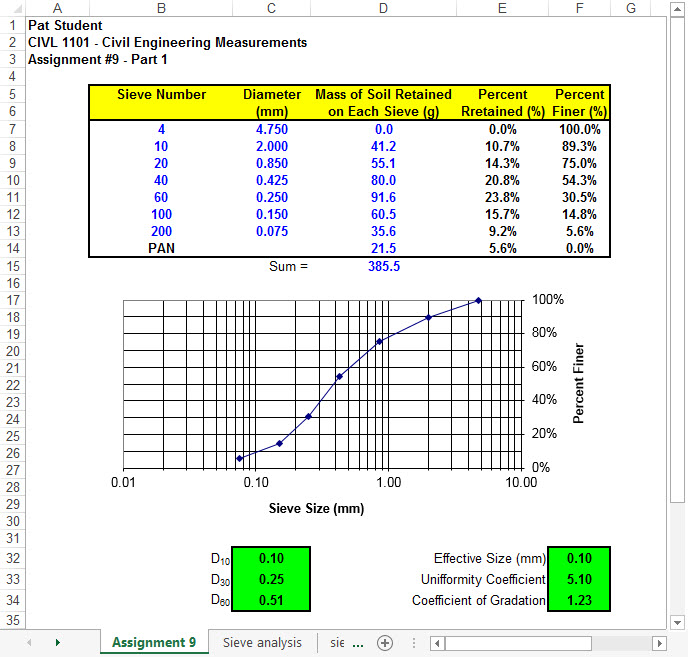|
"One is always a long way from solving a
problem until one actually has the answer." - Stephen Hawking
Objective
The purpose of this assignment is twofold: first, you will get yet another
chance to practice your skills in developing simple engineering spreadsheets for
civil engineering applications; second, you can use the spreadsheet to help
you with the mechanical analysis of soils used in the filter experiments. Submit your Excel file
for Parts 1-2 to the Assignment ink in Canvas.
Part 1: Develop a spreadsheet to develop the particle-size distribution plot
for a given data set. The information in blue
is the input data. The spreadsheet results are the value printed in black
and the particle-size distribution graph. Your spreadsheet should look similar to
the one shown below. Click
here for an
Excel template of this spreadsheet.

Use your spreadsheet to
develop a particle-size distribution plot for the following data:
Sieve Number |
Mass of soil retained
on each sieve (g) |
| 4 |
0 |
| 10 |
41.2 |
| 20 |
55.1 |
| 40 |
80.0 |
| 60 |
91.6 |
| 100 |
60.5 |
| 200 |
35.6 |
| Pan |
21.5 |
Estimate D10, D30,
and D60 from the particle-size distribution
curve and compute the effective size, the uniformity coefficient, Cu,
and the coefficient of gradation, Cc.
Part 2: Use your spreadsheet to
develop a particle-size distribution plot for the following data:
Sieve Number |
Mass of soil retained
on each sieve (g) |
| 4 |
0.0 |
| 8 |
0.1 |
| 16 |
303.6 |
| 30 |
183.1 |
| 50 |
6.9 |
| 100 |
0.1 |
| 200 |
0.0 |
| Pan |
0.0 |
Estimate D10, D30,
and D60 from the particle-size distribution curve. Compute the effective size, the uniformity
coefficient, Cu, and the coefficient of
gradation, Cc.
Extra Credit: Estimate D10, D30,
and D60 from the particle-size distribution curve using linear interpolation between appropriate
sieves using spreadsheet functions so that the entire sieve analysis computation is
automated.
Part 3: Read Chapter 9 in the
Strategies for Creative Problem Solving by Fogler and LeBlanc.
Coversheet for homework
This website was originally
developed by
Charles Camp for
CIVL
1101.
This site is
Maintained by the
Department of Civil Engineering
at the University of Memphis.
Your comments and questions are welcomed.
|



